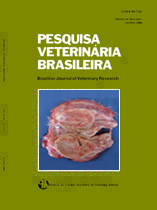 |
|
|
|
Year 2017 - Volume 37, Number 5
|

|
Infrared thermography of the ocular surface as stress indicator for piglets postweaning, 37(5):453-458
|
ABSTRACT.- Pulido-Rodríguez L.F., Titto E.A.L., Henrique F.L., Longo A.L.S., Hooper H.B., Pereira T.L., Pereira A.M.F. & Titto C.G. 2017. [Infrared thermography of the ocular surface as stress indicator for piglets postweaning.] Termografia infravermelha da superfície ocular como indicador de estresse em suínos na fase de creche. Pesquisa Veterinária Brasileira 37(5):453-458. Laboratório de Biometeorologia e Etologia, Faculdade de Zootecnia e Engenharia de Alimentos, Universidade de São Paulo, Av. Duque de Caxias Norte 225, Campus Fernando Costa, Pirassununga, SP 13635-900, Brazil. E-mail: crisgtitto@usp.br
Weaning is a critical phase in pigs’ life due to maternal separation and the introduction of a new diet. Infrared thermography measurement taken in the ocular region appears to be a reliable indicator of the stress condition of the pig. The aim of this study was to evaluate the relationship between ocular surface temperature by infrared thermography and cortisol in piglets post weaning. Sixty-six piglets were evaluated once a week, during 7 weeks, in two periods of the day (7am and 15pm) and ocular surface temperature and dorsal surface temperature were collected using a thermographic camera and a laser surface thermometer, respectively. Saliva was also collected to determine salivary cortisol. Statistical analysis included fixed effects of week and period of the day and their interaction, and relationship between thermography, dorsal surface temperature and cortisol were done by Pearson’s correlations with 5% significance level. Salivary cortisol did not differ between periods, but it was higher in the first three weeks after weaning (P<0.05). During the first two weeks after weaning cortisol presented high and positive correlation (P<0.05) between ocular surface temperature (0.89) and dorsal surface temperature (0.80). The two superficial temperatures had a moderate and positive association (r=0.41; P<0.0001) during all experiment. This study highlights that the ocular surface temperature obtained through infrared thermography can be a superficial body temperature indicators, besides being a non-invasive and fast method of measurement. However, more research is needed to deepen the relationship between ocular surface temperature and cortisol during chronic stress. |
| |
|
|
| |
|
 |